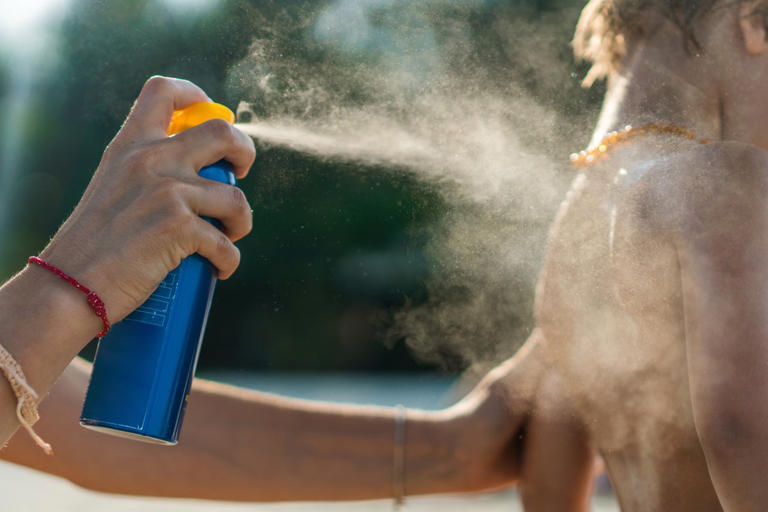How much sunscreen should you use and how often do you need to apply it?










How much sunscreen should you use and how often do you need to apply it?
As a heatwave sees temperatures reaching sweltering highs in parts of the US and Canada, slathering on sunscreen is necessary to keep your skin safe from damage.
But with different brands, SPFs, formulas, and methods of applying, it can be difficult to decipher just how much sunscreen you need to keep protected from the sun’s strong rays.
Fortunately, most dermatologists recommend a few main sunscreen application tips to keep your skin safe from the unrelenting glare.
According to the American Academy of Dermatology (AAD), one of the most important things to know is how much sunscreen you need to apply.
Although most people are aware that sunscreen needs to be reapplied, knowing how much to use is an integral part of the equation – especially because the application process varies when it comes to different formulas.
As a general rule for lotions and creams, the AAD recommends following the guideline of one ounce, or enough sunscreen to fill a shot glass, and then adjusting from there depending on your body size.
It may seem like a lot, but a shot glass-full dollop of sunscreen is typically enough to cover the exposed areas of the body from head to toe.
Sunscreen sprays are often considered less of a hassle than lotions, but it also means you need to be especially careful when applying in order to get the full SPF amount – and to keep from missing a spot on your body.
The necessary amount of coverage for a spray suncreen to be effective requires at least six seconds of spraying in each spot – roughly four seconds more than most people use.
Those opting for spray sunscreen should also rub the formula into the skin after spraying, especially if you are already outdoors, as the method can result in uneven coverage and unprotected skin, according to the AAD.
With sticks, often used for facial coverage, applying generously all over the face at least twice is recommended – and remembering your ears and eyelids is key.
As for the SPF and traits to look for in a sunscreen, the AAD recommends choosing a sunscreen that is at least 30 SPF or higher and offers broad-spectrum protection against both UVA and UVB rays - and applying 15 to 30 minutes before stepping outside.
When it comes to reapplying, the AAD advises people to reapply their sunscreen at least every two hours while outside, even when it is cloudy. If you are swimming or sweating, you should reapply more frequently, such as every time you exit the pool or ocean.
And before you head outside, make sure your sunscreen hasn't expired, as most formulas last about two to three years before they need to be replaced.
Story by Chelsea Ritschel: The Independent:
Articles-Latest
- 8 common mistakes that could be making your dry lips worse
- Dermatologist's insight on shower frequency without harming skin
- ‘Making Black More Beautiful’: Black Women and the Cosmetics Industry in the Post-Civil Rights Era
- A damaged skin barrier can leave you dry, itchy or oily. So, how do you fix it?
- What is collagen and why is it so popular in the beauty industry?
- Skin icing's not just for summer – this cryotherapy technique will get you party season ready
- How much sunscreen should you use and how often do you need to apply it?
- Are AHAs Safe?
- EXFOLIANTS - Cosmetics Unmasked
- ASTHMA - Toxic Beauty
- PHOTOSENSITIVITY - Toxic Beauty
- How to Tighten Your Loose Skin After Weight Loss
- Everything You Need To Know Before Getting A Septum Piercing
- What you should know about treating rosacea in darker skin tones
- Shampoos and Conditioners Designed to Soothe Dry, Itchy Scalps
- 3 things an expert wants you to know before getting filler
- Dissolving filler: everything you need to know
- How thread lifts differ to facelifts – and filler injections
- People are using face tape to minimise wrinkles, but does it work? After asking a plastic surgeon, I tried it for myself
- Reality of Black beauty influencing - making foundation with eyeshadow and unequal pay
Cosmetic ingredients
LOGIN
Who's On Line
We have 49 guests and no members online
Articles-Most Read
- Home
- Leucidal
- White Bees Wax
- Cosmetic Preservatives A-Z
- Caprylyl Glycol
- Cosmetics Unmasked - How Safe Are Colorants?
- Cosmetics Unmasked - Choosing Ingredients
- Cosmetics Unmasked - Colorants And Fragrances
- EcoSilk
- Toxic Beauty - Who's Looking At Cosmetics?
- Cosmetics Unmasked - Fragrances
- Microbes and Cosmetics
- Chemicals Lingering In The Environment
- Microbes and Safety Standards
- Toxic Beauty - Hazardous To Your Health
- Yellow Bees Wax
- Potassium Sorbate
- Synthetics In Cosmetics - The Industry Fights Back
- Fresh Goat's Milk Soap
- Active Ingredients
- What's Happening in the USA - Cosmetic Regulations - Toxic Beauty
- Cosmetics Unmasked - Listing Cosmetics
- Natural Waxes A-Z
- Toxic Beauty - Cocktails and Low Doses
- Natural Butters A-Z



